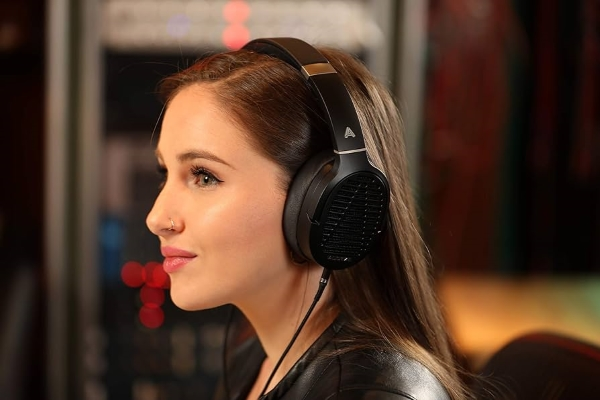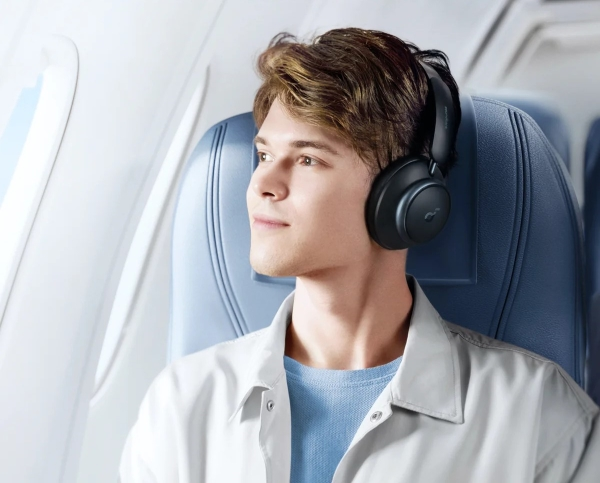Decoding 18 Types of Headphones: Ultimate 2024 Audio Guide
Welcome to my ultimate guide on exploring the diverse types of headphones available in today’s ever-evolving audio market! Navigating the world of audio devices can seem daunting, especially if you’re just starting your journey in search of the perfect listening experience.
My friendly guide, designed specifically for beginners, will help you understand different types of headphones. I’ll cover everything from in-ear, over-ear, wired, and wireless to noise-canceling—and their roles in enhancing your audio experience. Let’s embark on this exciting adventure together and unlock superior sound quality!
You may like: 5 Key Distinctions Between Headphones and Earphones
Why Understanding Different Types of Headphones Matters?

Decoding the different types of headphones goes beyond mere product knowledge. It’s about embarking on a journey to explore your unique needs and preferences and using that understanding to unlock a superior audio experience.
Sound Quality
Different types of headphones deliver diverse sound profiles. For instance, in-ear headphones offer immersive isolation. In contrast, open-back over-ear headphones are lauded for delivering a wide soundstage resembling live performances. Understanding these distinctions can guide you toward headphones that cater to your preferred listening experiences.
Fit and Comfort
Are you someone who enjoys long hours of music, or are you a speed listener catching up on podcasts on the go? The choosing point of an in-ear or over-ear set will largely depend on this factor. Each style comes with its unique comfort level, cushioning, and ergonomics.
A clear understanding can help you choose a pair that lets you enjoy audio bliss comfortably without causing ear fatigue.
Application
Lastly, different headphone types cater to varied applications. Do you need a pair for your daily commute, gym routines, in-house music production, or professional gaming?
Someone with an active lifestyle like me will choose convenient wireless headphones, while those who like isolation tend to stick with noise-cancelling headphones. The relevance of the headphones to the user’s activity further emphasizes the importance of understanding these types of headphones.
Therefore, getting familiar with different types of headphones isn’t just a technical detour—it’s a path toward elevating your audio experience.
With knowledge comes the power to make an informed choice to meet your needs, maximize your comfort, and enhance your listening experience like never before. Remember, your headphones are not just devices; they’re your gateway into the world of sound.
3 Types of Headphones Based on Design
As we delve deeper into the world of headphones, let’s take a closer look at three primary designs that dominate the market – in-ear, on-ear, and over-ear headphones.
Each design type offers unique characteristics and benefits, influencing the sound, comfort, and even the style of your audio experience. Get ready to explore these design varieties and discover the style that suits you best.
Over-ear Headphones

Over-ear headphones, or around-ear or circumaural headphones, are the largest of the headphone family. They completely envelop the user’s ears with ear cups large enough to encase them. The design offers a mix of immersive sound experience and comfort, as the cups’ padding reduces the pressure applied directly to the ears.
Pros & Cons
Over-ear headphones come with a plethora of benefits:
- High Sound Quality: They usually deliver superior audio quality with excellent depth and volume. The large drivers within the ear cups can deliver powerful bass and detailed sound.
- Comfort: The large, padded ear cups make them comfortable for extended use, eliminating discomfort from prolonged use.
- Good Noise Isolation: The over-ear design also provides good passive noise isolation since the ear cups seal around your ears, blocking ambient noise.
On the downside, their size and weight can make them:
- Less Portable: Over-ear headphones are larger and heavier than other types, which may not be ideal for on-the-go listening.
- Heat Buildup: The enclosed design might also cause heat buildup when worn for a long time, leading to potential discomfort.
Ideal Usage Scenarios
Over-ear headphones excel in environments where high-quality sound and comfort are priorities, typically at home or in the studio.
Music professionals often use over-ear headphones for mixing and mastering because of the superior soundstage and detail they offer. Many gaming enthusiasts also favor them, as they provide immersive audio experiences that can enhance gameplay.
When using the computer at home, I often wear over-ear headphones to listen to music. Movies, when enjoyed with those headphones, also bring more remarkable experiences. While not the most portable, over-ear headphones are an excellent choice for those prioritizing exceptional audio quality and comfort over portability and looking for headphones for stationary settings like home, office, or studio.
On-ear Headphones

On-ear headphones, also called supra-aural headphones, sit directly on the outer ear. They are relatively compact and lighter than over-ear headphones, making them a comfortable middle ground between over-ear and in-ear models.
The headphone’s design involves padding sitting on the ear, rather than around them, held in place by a band over the head.
Pros & Cons
On-ear headphones offer unique benefits:
- Portability: They are lighter and smaller than over-ear models, making them travel-friendly.
- Comfortable for Extended Use: They can be worn for extended periods without causing ear fatigue, so long as the clamping force isn’t overly strong.
- Decent Sound Quality: While not matching the richness and depth of over-ear models, on-ear headphones still deliver good quality of sound.
However, they do have their limitations:
- Reduced Noise Isolation: They don’t seal around the entire ear like over-ear headphones, leading to lesser noise isolation and potentially more sound leakage.
- Potential Discomfort: If the headband is too tight, wearing them for long periods can cause discomfort.
Ideal Usage Scenarios
On-ear headphones serve those who desire better quality of sound and comfort than in-ear models can offer but require more portability than bulky over-ear models provide.
They are an excellent choice for travelers, commuters, office workers, or anyone who seeks a decent mix of comfort, sound quality, and portability. They’re also popular among users who want to remain partially aware of their surrounding ambient noise for safety or convenience, as they don’t isolate external noise as much as over-ear models do.
In a nutshell, on-ear headphones strike a balance between portability, sound quality, and convenience, making them a versatile choice for various audio experiences.
In-ear Headphones

In-ear headphones, also known as earbuds or in-ear monitors (IEMs), are the smallest and most portable types of headphones.
The design consists of small, lightweight earpieces that rest in the entrance to the ear canal. These headphones come in various styles, from the classic wired models to true wireless earbuds.
I will not hesitate to say that earbuds are one of the most valuable inventions of the 21st century. It’s convenient, portable, and has good sound quality. I wear earbuds almost every time I can: when commuting, when working, when exercising, and when reading.
Pros & Cons
In-ear monitors offer a range of advantages:
- Portability: Their compact size and lightweight design make them extremely portable and ideal for on-the-go use.
- Noise Isolation: The proper fit of ear tips provides excellent noise isolation by sealing the ear canal and blocking external noise.
- Diverse Options: From budget-friendly to high-end models and wired to true wireless designs, in-ear headphones cater to all preferences and purposes.
However, they come with some drawbacks:
- Comfort and Secure Fit: Wearing them for extended periods can become uncomfortable for some users or require frequent adjustments to maintain a secure fit.
- Sound Quality Variability: While higher-end models can deliver exceptional quality of sound, budget options can be disappointing compared to on-ear or over-ear models within the same price range.
Ideal Usage Scenarios
In-ear monitors are designed for users who prioritize portability and need headphones to accommodate busy, on-the-go lifestyles. Their lightweight design and efficient noise isolation make them well-suited for exercising, commuting, and traveling.
With sweat-resistant and true wireless options available, in-ear monitors cater to sports enthusiasts and users who prefer a minimalistic and tangle-free experience.
Moreover, with many available options, in-ear monitors present suitable choices for users with varied budgets. However, it’s important to note that the right fit is vital. Ensure you find ear tips that provide the best comfort, noise isolation, and secure fit based on your ear shape and size.
In-ear headphones appeal to users who seek portability, noise isolation, and fuss-free design that complements their fast-paced lifestyles. From budget to premium options, you can find the in-ear headphones that best suit your needs and desired sound quality.
5 Types of Headphones Based on Technology Features
Beyond the physical design, headphones also vary based on the technology features they incorporate. This section provides a detailed overview of the different types of headphones classified by key technological attributes. Understand these intricacies to find the pair that most suits your needs for sound quality, convenience, and specific usage scenarios.
Closed-back Headphones

Closed-back headphones, as the name suggests, have a closed-off backside to the ear cup. This design creates a chamber from which sound directly enters your ears without escaping to the environment or ambient noise entering your audio space. Closed-back models come in all sizes—over-ear, on-ear and in-ear.
Pros & Cons
Closed-back headphones offer several significant benefits:
- Noise Isolation: The closed design helps isolate ambient noise, offering a more immersive listening experience.
- Minimal Sound Leakage: The closed-off back prevents sound leakage, so your music stays with you and doesn’t disturb others around you.
- Enhanced Bass: The closed chamber often amplifies low frequencies, providing more substantial bass performance.
However, they do come with certain drawbacks:
- Sound Stage: Closed-back headphones sometimes give a sense of sound coming ‘inside your head’ rather than from around you, giving a less natural listening experience.
- Heat Buildup: The enclosed design might cause heat and moisture buildup inside the ear cups during extended usage.
Ideal Usage Scenarios
Closed-back headphones are ideal for environments where you want to block out the world around you and not disturb people nearby with your music—be it commuting, office use, or in shared living spaces. Their noise-isolating feature and lack of sound leakage make them perfect for personal audio experiences.
Additionally, due to their pronounced low-end frequencies, these headphones are preferred by users who enjoy bass-heavy music or want to focus on specific sound details, like beat production, etc. They are also an excellent fit for studio recording sessions where microphone bleed must be minimized.
Closed-back headphones cater to those who want a more isolated, private, and undisturbed listening experience. With the right balance of improved bass response and no sound leak, they serve well in most everyday usage scenarios.
Open-back Headphones

Open-back headphones feature ear cups with perforated or vented backings, allowing air to pass through the ear cups and the sound to interact with the environment. In contrast to their closed-back counterparts, these headphones create an open, spacious audio experience. Open-back design is usually found in over-ear and on-ear headphone styles.
Pros & Cons
Open-back headphones offer a unique set of advantages:
- Sound Stage: The open design results in a wider and more natural soundstage, creating a more immersive and “live” listening experience.
- Cooler Listening: The ventilated earcups alleviate heat and moisture buildup, providing a more comfortable experience during long listening sessions.
- Speaker-like Feel: The sound interaction with the environment can make it feel like the audio comes from speakers in a room rather than headphones.
However, these headphones present specific drawbacks:
- Lack of Noise Isolation: The open design does not block out ambient noise, affecting the listening experience in noisy environments.
- Sound Leakage: The open nature of the headphones causes sound to leak out, potentially disturbing people around you.
Ideal Usage Scenarios
Open-back headphones are best suited for quiet, controlled environments such as home listening or studio use. They excel when a natural, spacious soundstage is more important than blocking out background noise. Professionals and audiophiles who need a detailed, accurate, and uncolored sound profile for mixing or sound design may prefer open-back headphones.
Since sound leakage and the lack of noise isolation could be problematic in public settings, open-back headphones are not ideal for commuting, shared office spaces, or usage where privacy is a priority.
Open-back headphones cater to users who prioritize a natural, spacious, and immersive soundstage within quiet environments. They are popular among audiophiles and professionals who value sound accuracy and realistic audio presentation above noise isolation and sound leakage prevention.
Noise-cancelling Headphones

Noise-canceling headphones utilize advanced technology to actively minimize ambient noise, allowing users to listen to audio content without raising the volume excessively. They are more advanced than noise-isolating headphones, which can only prevent some background noise thanks to their design and materials.
This technology works by using microphones that capture external noises and transmit sound waves to internal circuitry that generates opposing sound waves to cancel them out. Noise-canceling features can be found in in-ear, on-ear, and over-ear designs.
Pros & Cons
Active noise-cancelling headphones bring several notable benefits:
- Quieter Listening Environment: These headphones actively block outside noise, which enhances the listening experience in noisy environments.
- Lower Volume Listening: With less ambient noise, users can listen at lower volumes, reducing potential ear damage due to high-volume listening over long periods.
- Enhanced Concentration: These headphones can provide a nearly silent environment for listeners who want to work in peace or enjoy music without disruptions.
However, noise-cancelling headphones also have certain disadvantages:
- Power Dependency: Active noise cancelation (ANC) technology requires power, usually provided by batteries or a USB power source. If the battery runs out, the noise-canceling feature will cease to operate.
- Potential Sound Quality Compromise: ANC might slightly affect audio quality in some models, altering the sound profile or adding a hiss.
- Pressure Sensation: Some users report a sensation of ear pressure while using noise-canceling headphones.
Ideal Usage Scenarios
Noise-canceling headphones are particularly beneficial for users frequently in noisy environments, like commuting, traveling, or working in loud spaces. Their ability to limit intrusive ambient noise helps listeners have a better audio experience, focus on work, or enjoy peaceful silence without cranking up the volume.
I must say that the power of technology is remarkable. Through improvements and updates, noise-cancelling headphones have become more effective, providing near-silent conditions even in noisy surroundings.
However, because of their power dependency and potential effect on sound quality, they might not be the first choice for users who prioritize sound purity over noise cancellation.
Noise-canceling headphones accommodate listeners seeking respite from noisy environments or ambient sounds, aiding focus and offering a quieter, more personal audio space to enjoy music or other audio content.
Bone Conduction Headphones

Bone conduction headphones, or open-ear headphones, represent an innovative technology in the audio industry, offering a unique way of listening to music.
Instead of using traditional air conduction, these headphones transmit sound waves directly to the inner ear via the bones (often the jaw or cheekbones). They typically have a behind-the-neck design, where the transducers rest on the skull or cheekbones rather than the ears.
Pros & Cons
Bone conduction headphones provide several advantages:
- Situational Awareness: As these headphones do not cover or block the ears, they leave the ear canals open, allowing users to hear surrounding sounds and maintain situational awareness.
- Comfort and Safety: They can be a viable alternative for individuals who find regular headphones uncomfortable or those with certain hearing conditions.
- Wearability with Protective Gear: They can be worn with hats, glasses, and even ear protection gear, making them an ideal option for specific activities and professions.
However, they also have certain limitations:
- Sound Quality: The sound quality is often not as good as traditional headphones, especially for bass frequencies.
- Less Noise Isolation: They don’t block out ambient noise as effectively as other headphones, as they don’t cover the ears.
- Audible Leaks: The sound could be audible to people nearby at higher volumes.
Ideal Usage Scenarios
Bone conduction headphones are ideally suited for environments and activities where maintaining awareness of surroundings is crucial – like walking, running, biking, or working onsite.
They are also a great option for people with certain hearing impairments as they bypass the eardrums, directly delivering sound waves to the inner ear canal.
As these headphones don’t fully block ambient noise and their sound quality doesn’t match traditional headphones, they might not be recommended for audiophiles or those prioritizing premium sound quality.
Bone conduction headphones offer a unique listening experience that doesn’t compromise environmental awareness and safety. They serve well for active lifestyles, certain professions, and those with specific hearing conditions who want a different, comfortable audio solution.
Air-Tube Headphones

Air-tube headphones, renowned for their radiation-free design, feature a unique technology that transmits sound through hollow air tubes. They minimize the use of electronic components near the ear, thereby reducing electromagnetic exposure.
Frequently comfortable, lightweight, and portable, these headphones offer a safer option for those concerned about radiation.
Pros & Cons
Air-tube headphones provide notable advantages:
- Reduced Radiation: They lower exposure to potentially harmful electromagnetic fields.
- Portability: Their minimalist design makes them easy to carry along.
- Comfort: Lightweight design and less ear pressure provide overall comfort.
Nevertheless, there are potential drawbacks:
- Sound Quality: The sound may lack bass or depth compared to traditional headphones.
- Durability: The air tube part might be prone to damage over time.
Ideal Usage Scenarios
Air-tube headphones are perfect for individuals concerned about radiation from electronic devices. Whether you’re commuting, at work, or in bustling urban environments, these headphones provide a safer option while delivering a satisfactory audio experience, providing peace of mind alongside your favorite tunes.
2 Types of Headphones Based on Connectivity
Another significant factor to consider when choosing headphones is the connectivity mode. Broadly speaking, there are two primary types of connections – wired and wireless. Each type carries its unique advantages and possible drawbacks, influencing your overall listening experience. Let’s delve into each kind further.
Wireless Headphones

Wireless headphones, often through Bluetooth technology, allow users to connect to various devices without needing a physical cable.
Bluetooth wireless headphones offer freedom from wires and increased portability from mobile phones and tablets to laptops and televisions. They come in various styles, including over-ear, on-ear, and in-ear models, and are among the most favorite types of headphones.
Pros & Cons
Wireless Bluetooth headphones carry several noteworthy benefits:
- Flexibility and Convenience: Freed from cables, these headphones are less prone to tangling and give users increased mobility.
- Multi-device Connectivity: Many models can be paired with multiple devices simultaneously, making switching between different audio sources easy.
- Enhanced Features: Many wireless headphones come packed with features like touch controls, built-in microphones, and even voice assistants.
However, these wireless headphones do also have certain downsides:
- Dependence on Battery: These headphones require regular charging since they function wirelessly. Battery life varies from model to model, and longer use could demand frequent charging.
- Occasional Connectivity Issues: Bluetooth connections may experience latency or interruptions depending on the environment and the distance from the connected device.
- Sound Quality: While technological advancements have brought considerable improvement, wired headphones often still offer superior sound quality, especially for high-resolution audio.
Ideal Usage Scenarios
Wireless headphones are particularly useful in situations demanding freedom of movement and flexibility, such as commuting, fitness activities, or traveling. Their convenience, combined with improved sound quality and added features, makes them an attractive choice for many daily situations.
However, for activities that call for extended usage, like marathon gaming or video editing, the headphone’s battery life could be a limit. Audio professionals or enthusiasts seeking the best audio resolution may also gravitate more toward wired headphones due to their often superior sound fidelity.
Wireless and Bluetooth headphones are an excellent choice for users seeking convenience, flexibility, and modern features in their audio devices. They complement active, mobile lifestyles and cater to practicality without severely compromising sound quality.
Wired Headphones

Traditional wired headphones connect to audio devices using a cable, typically a 3.5mm or 6.35mm jack, or, more recently, via a USB or Lightning connector.
Available in a multitude of styles, such as in-ear, over-ear, or on-ear models, wired headphones have long been a staple in consumer and professional audio markets.
Pros & Cons
Wired headphones come with numerous advantages:
- Superior Audio Quality: As a rule of thumb, wired headphones often deliver better sound quality than their wireless counterparts, especially regarding high-resolution audio.
- No Batteries Required: Wired headphones do not require charging, making them reliable for extended sessions without worrying about battery drainage.
- Negligible Latency: With a direct signal pathway, wired headphones have practically no latency, making them perfect for real-time applications.
Despite these benefits, wired headphones do present certain drawbacks:
- Limited Mobility: The cable restricts the range of movement and can get tangled during storage or use.
- Dependence on Device Jack: As some modern devices remove the traditional audio jack, using wired headphones can require an additional adapter.
Ideal Usage Scenarios
Wired headphones are ideal for settings where sound quality, reliability, and negligible latency are prioritized over mobility. They’re often preferred by audiophiles and professionals like audio engineers, DJs, or gamers who require real-time audio responsiveness and the best audio quality.
With the removal of the headphone jack in many of the latest devices, wired headphones could be limited or require extra hassle to connect.
However, wired headphones still present an excellent option for users who value pure audio fidelity and uninterrupted use. I think wired headphones are still the best choice for a computer setup. They ensure sound quality and bring comfort without worrying about battery life.
Wired headphones are preferred for users seeking superior sound quality and a reliable, uninterrupted listening experience. Despite their limitation in mobility compared to wireless models, their sound fidelity, dependability, and zero-latency facets remain unbeaten, making them a favorite among audio enthusiasts and professionals.
3 Types of Earbuds You Should Know About
Earbuds come in various styles, each fulfilling different user needs and preferences. Here, we’ll explore three major types of earbuds classified based on connectivity options – wired, wireless, and the relatively newer, true wireless earbuds – to help you understand their distinctive traits and functionalities.
Wired Earbuds

Wired earbuds connect to audio devices through a cable and typically feature a 3.5mm connector or, more recently, a USB or Lightning connector for newer devices. Lightweight and compact, wired earbuds are often an in-ear style, fitting directly into the ear canal, and often come with various sizes of ear tips for a more custom fit.
Pros & Cons
Wired earbuds carry several notable pros:
- Reliable Sound Quality: Like their larger counterparts, wired earbuds often deliver better sound quality than wireless ones, with higher fidelity and more detailed audio.
- No Battery Required: There’s no need to worry about battery life, as wired earbuds don’t need to be charged.
- Affordable: Generally, wired earbuds are less expensive than wireless models.
However, they also have some cons:
- Limited Mobility: The presence of a wire restricts movement range and can be cumbersome during active uses.
- Prone to Tangling: Wired earbuds can easily get tangled when stored improperly, leading to wear and tear over time.
Ideal Usage Scenarios
Wired earbuds are an excellent companion for day-to-day use due to their compact size and convenience. They’re perfect for listening to music or podcasts during commutes, walking, or home. Wired earbuds are a great solution for individuals who value good sound quality or prefer not to worry about battery life.
On the flip side, they may pose a challenge for sports or gym usage due to a wire’s restrictive and potentially annoying presence. Using wired earbuds can require an additional adapter for the most recent devices that have eliminated the headphone jack.
Wired earbuds provide a reliable, affordable, high-fidelity option for users who value sound quality and convenience. Despite the slight mobility limitation, they remain popular for everyday audio needs.
Wireless Earbuds

Wireless earbuds connect to audio devices via Bluetooth, offering a cable-free listening experience.
These earbuds come in two variants:
- Neckband style: Two earbuds are connected via a wire or band that rests around your neck
- True wireless: The earbuds operate independently without any wires.
Pros & Cons
Wireless earbuds present several advantages:
- Increased Mobility: Free from wires, they allow greater freedom of movement, making them particularly suitable for active uses like workouts or commuting.
- Modern Features: Many wireless earbuds now come with advanced features, such as touch controls, built-in microphones, active noise cancellation, and voice assistant integration.
- Convenience: The absence of a physical connection to your device adds convenience, especially when cord tangling can be a nuisance.
But they also have their cons:
- Dependent on Battery: Wireless earbuds require regular charging. While many models come with a charging case providing additional charges, battery management becomes an additional consideration for users.
- Sound Quality: While improving, the sound quality of wireless earbuds may still fall behind compared to wired models, particularly for high-resolution audio.
- Potential Loss Risk: Especially for true wireless earbuds, there can be an increased risk of misplacement or loss due to their small size.
Ideal Usage Scenarios
Wireless earbuds are perfect for situations requiring a good range of motion without wires, such as during physical activities, gym exercises, running, or commuting. Their modern features and convenience also fit well with the wearers’ active, modern lifestyles.
However, the need to periodically charge can be a downfall for extended listening sessions or in cases where charging isn’t convenient. Audiophiles might prefer wired alternatives for a more premium sound quality.
Wireless earbuds are ideal for active individuals seeking mobility, convenience, and the benefits of modern features in their audio devices. Despite the battery dependency and often lesser sound fidelity, they provide an excellent blend of comfort, freedom, and functionality for daily use.
True Wireless Earbuds

True wireless earbuds are a subcategory of wireless earbuds where the two earpieces operate independently without any wires connecting them. We write it in a separate section due to its rising popularity in the world of personal audio devices.
True wireless earbuds use Bluetooth technology to connect to audio devices and often come with a compact charging case, which serves as both storage and a battery backup for on-the-go charging.
Pros & Cons
True wireless earbuds offer several benefits:
- Ultimate Mobility: Completely free from wires, these earbuds provide users with the highest level of mobility, ensuring all movements are unhindered.
- Compact Design: Their small size and charging case make them easily portable, fitting comfortably in pockets or bags.
- Modern Features: Like their wireless counterparts, true wireless earbuds often have advanced features, such as touch controls, built-in microphones, active noise cancellation, and voice assistant integration.
Nonetheless, true wireless earbuds present certain drawbacks:
- Battery Life: Despite the charging case, their smaller size generally results in shorter battery life than other wireless models.
- Sound Quality: While constantly improving, true wireless earbuds may still lag behind wired earbuds regarding sound quality, particularly for high-resolution audio.
- Loss Risk: Due to their small size and individual components, true wireless earbuds pose an increased risk of misplacement or loss.
Ideal Usage Scenarios
True wireless earbuds are ideally suited for dynamic, active lifestyles, as they offer the utmost freedom of movement without the inconvenience of wires. They’re perfect for sports, fitness activities, running, and commuting and for users who desire a sleek, discreet look without sacrificing modern features.
However, battery life and charging management may be challenging for extended usage or when charging convenience is limited. Those seeking optimal audio quality might prefer wired alternatives.
Among the people around me, the number of people using earbuds seems overwhelming compared to other types of headphones. The convenience it brings cannot be denied.
True wireless earbuds are the epitome of mobility, sleekness, and modern convenience for users seeking a truly untethered audio experience. While their battery life and sound quality might not match their wired counterparts, their overall advantages make them popular, especially among fitness enthusiasts and people on the move.
5 Different Types of Headphones Based on Use-Case and Lifestyle
Whether you’re an avid audiophile, gym enthusiast, frequent traveler, or casual listener, headphones cater to a wide range of lifestyles. Explore five distinct types of headphones tailored to suit different use cases and lifestyles, optimized for your listening comfort and convenience.
Music Production Headphones

Music production headphones are tailor-made for the rigorous demands of professional audio work. These headphones offer a balanced and precise audio output, facilitating critical listening and accurate adjustments during music production.
Designed with sound isolation and comfort in mind, they often feature over-ear or on-ear designs, using premium materials and advanced technology to keep the listener focused and comfortable during long periods of use.
These headphones are perfect for those involved in professional music production, such as music producers, sound engineers, and DJs who require a precise replica of their work.
Pros & Cons
Music production headphones offer several benefits:
- Superior Sound Quality: They reveal subtle details in recordings, a key factor in professional music production.
- Comfort: Designed for long-term use, these headphones provide comfort during extensive music production sessions.
- Sound Isolation: They ensure a pure and undisturbed listening environment by minimizing interference from external noises.
However, they also have potential drawbacks:
- Higher price points due to the premium materials and specialized features.
- Bulky design compared to headphones designed for casual listening due to their focus on sound quality and isolation.
Gaming Headphones

Gaming headphones are immersive audio devices designed to elevate the gaming experience. They feature surround sound capabilities and precise directional audio cues and often incorporate built-in microphones for clear in-game communication.
Comfortable for prolonged wear, these headphones often feature adjustable headbands and cushioned ear padding to reduce fatigue during long gaming sessions. Gaming headphones are ideal for both casual and professional gamers who want accurate sound and to enhance their in-game audio experience.
With the development of the gaming industry, the gaming headset category is increasingly growing among headphones. Honestly, I was shocked to discover the prices of some professional gaming headset models.
Pros & Cons
Gaming headphones offer several advantages:
- Immersive Experience with surround sound capabilities.
- Precision audio, thanks to their directional audio cues.
- Communication clearly and effectively with the built-in microphones.
However, they also come with potential drawbacks:
- High cost, especially for advanced models with extensive features.
- Limited usage for general multimedia consumption.
Exercise/Fitness Headphones

Exercise and fitness headphones are designed to keep up with active lifestyles, combining lightweight and comfortable design with robust durability.
Built to withstand rigorous workouts, these headphones typically feature sweat resistance, secure fit options like ear hooks or neckbands, and breathable materials. Wireless options are popular for fitness headphones, ensuring tangle-free, uninhibited workouts.
Exercise and fitness headphones are perfect for fitness enthusiasts or anyone who enjoys listening to music while engaging in physical activities.
Pros & Cons
Exercise and fitness headphones come with several advantages:
- Mobility: Wireless designs allow for unrestricted movement during workouts.
- Durability: Sweat-resistant and robust construction ensures longevity, even with frequent use.
- Secure Fit: Ear hooks or neckbands offer stability, preventing the headphones from falling out during vigorous exercise.
However, there are possible downsides to consider:
- Sound Quality: Prioritizing mobility and durability may compromise sound quality in some models.
- Battery Life: Wireless options require regular recharging, which can be inconvenient for some users.
Casual Listening Headphones

Casual listening headphones are designed to cater to individuals who seek enjoyable music experiences throughout their everyday lives.
Featuring a wide range of designs, from on-ear to over-ear and even in-ear, these types of headphones prioritize comfort, aesthetics, and balanced sound quality. Wireless and wired options are available, meeting the needs of diverse preferences. Additionally, user-friendly controls and connectivity options add to the convenience.
Casual listening headphones are ideal for people who want to enjoy music during daily activities such as commuting, leisurely walks, or relaxing at home. Suited for a vast range of users, these headphones provide a balance between comfort, convenience, and sound quality, making them a reliable companion for mundane tasks or moments of respite.
You may like: 10 Best Affordable Headphones in the Philippines
Pros & Cons
Casual listening headphones offer several advantages:
- Versatility: They cater to various preferences with varying designs, features, and price ranges.
- User-Friendly: Easy controls and simple connectivity options ensure hassle-free operation.
- Aesthetics: Many models focus on stylish designs that complement users’ fashion choices.
However, potential drawbacks include:
- Build Quality: Lower-priced options may lack durability or exhibit unimpressive sound performance.
- Specialization: Casual listening headphones typically do not cater to specific professional or niche needs.
Travel Headphones

Travel headphones are purpose-built for frequent flyers and commuters, delivering high-quality sound in a portable, comfortable, and noise-isolating design.
They often feature active noise cancellation technology to block out ambient noise, allowing travelers to enjoy their music or media uninterrupted. Foldable and compact, these headphones are easy to pack and carry on any journey.
Pros & Cons
Travel headphones offer several benefits:
- Noise Cancellation: Active noise cancellation technology enhances the listening experience in noisy environments.
- Compact Design: Foldability and lightweight designs make these headphones travel-friendly.
- Comfort: Padded earcups ensure comfort during long flights or commutes.
However, they also come with potential drawbacks:
- Cost: High-quality travel headphones with advanced features can be relatively expensive.
- Battery Life: Repeated use of active noise cancellation can drain battery life quickly.
Factors to Consider When Choosing Headphones
2. Comfort: Consider the fit and weight of the headphones for comfort during extended use.
3. Lifestyle: Choose headphones that align with your lifestyles, such as noise-cancelling for travelers or wireless earbuds for fitness enthusiasts.
4. Durability: Look for durable headphones that can withstand daily use and travel.
5. Price: Headphones can range from budget-friendly to extremely high-end. Decide on your budget and choose the best within that range.
6. Brand & Warranty: Renowned brands provide better customer support, and a good warranty ensures repair or replacement without additional costs.
Choosing the right pair of headphones extends beyond merely picking a device for listening to audio. It involves considering multiple factors, such as sound quality, comfort, lifestyle fit, durability, price, and brand credibility.
Here, I break down each factor to assist you in making an informed decision.
Sound Quality

Sound quality is arguably the most significant factor when looking for headphones. Each type produces a distinct sound signature, which can profoundly impact your listening experience.
For instance, bass-heavy headphones are great for genres like hip-hop or EDM, whereas balanced-sound headphones might be better for classical or jazz music.
Do your research and test them out (if possible) to find a pair that best complements your music preference. In my experience, many retailers have product displays where you can experience the product firsthand before deciding. This is really useful because there are things you can only discover if you use the product directly.
Also, remember that professional audio needs require different specifications, so a studio musician might opt for a ‘flat’ sound profile that accurately represents recordings.
Comfort
Comfort can significantly affect your overall headphone experience. Essentially, if they’re uncomfortable, you won’t use them, no matter how great they sound.
In-ear models are lightweight and portable, but some people find them uncomfortable due to the earbuds sitting in the ear canal.
On the other hand, over-ear or around-ear headphones are typically more comfortable for extended use because they distribute weight around the ears, not on them, but can feel heavier.
Consider how long you’ll be using them daily and choose a comfortable fit accordingly.
Lifestyle
Your lifestyle is an integral part of the decision-making process. Are you a frequent traveler or need something for your daily commute? Noise-canceling headphones would be an efficient option.
Wireless, waterproof, and secure-fitting earbuds would be a better choice if you’re a fitness enthusiast.
Larger, more substantial models like open-back headphones could provide a superior audio experience for those using headphones at home or in a studio.
Durability
Everyone wants a product that will last. Spending more on a robust, quality set of headphones that can withstand daily use and travel is more cost-effective over time than replacing cheaper headphones every few months. Look for well-constructed headphones, solid-feeling plastics, or preferably metal headbands with securely fitted hinges.
Price

Headphones can range from budget-friendly to extremely high-end. The price often gives you a good idea of the headphones’ sound quality, build, and sophistication of technology.
Note while you get what you pay for, there are diminishing returns above certain price brackets. Decide on your budget and choose the best within that range, providing an excellent balance of all the other factors.
Brand & Warranty
Renowned brands are usually trustworthy and often provide better customer support. They stand behind their products with credibility and an established reputation in the market.
Additionally, make sure to check warranty coverage. A good warranty provides security that if anything goes wrong, you can get them repaired or replaced without incurring additional costs.
Ultimately, the right headphones will deliver a harmonious sound quality, comfort, durability, and price balance that fits your lifestyle and listening needs.
It’s essential to take time to evaluate these factors meticulously. This approach ensures that your investment in your audio experience pays off satisfactorily – making every tune, podcast, or movie more enjoyable.
Recap on 18 Types of Headphones
Choosing the right pair of headphones is crucial for optimum listening experiences. I presented various types of headphones based on the different criteria above.
Each type offers specific advantages tailored to various needs and preferences. You can confidently select the perfect pair to enhance your audio world by understanding their key features and ideal usage scenarios.
Explore and share your favorite picks on the HomeToppicks website, and please feel free to comment, like, and check out related posts for more expert recommendations on headphone-related products. Happy listening!
Tags: How-to
Tony, an experienced engineer and tech enthusiast, brings his expertise to Hometoppicks, where he oversees the Electronics and Entertainment Equipment sections. With his hands-on experience and in-depth knowledge of the latest trends, Tony provides reliable product recommendations and valuable insights into cutting-edge tech. You can find more about him here.
